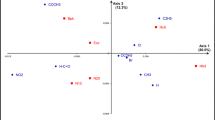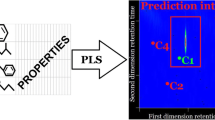Abstract
Quantitative structure-retention relationship (QSRR) studies have proved to be a valuable approach in the prediction of the gas chromatographic relative retention time (GC-RRT) of organic chemicals. Polybrominated diphenyl ether (PBDE) congeners are now ubiquitous environmental pollutants. Of the 209 possible PBDE congeners, 126 have been synthesized and their retention-time data on seven different stationary phases has been determined [Korytár et al.:J Chromatography A 1065:239–249, (2005)]. To estimate and predict the GC-RRT values of all 209 PBDEs on different stationary phases, 17 molecular descriptors from the semi-experience algorithm in MOPAC program and the topological structures of PBDE molecules were calculated. By means of the VSMP (variable selection and modeling based on prediction) program [Liu et al.:J Chem Inf Comput Sci 43:964–969, (2003)], six optimal descriptors were selected to develop a QSRR model for the prediction of GC-RRT of PBDE. The descriptors contain some energy information (such as the energy of the lowest unoccupied molecular orbital and highest occupied molecular orbital) and topological information (the number of ortho-, meta-, and para- substituted bromine atoms) as well as the molecular weight (lnM W ). All the models developed were cross-validated using leave-one-out (LOO). For seven GC stationary phases, the estimated correlation coefficients (r 2) are all more than 0.985 but for the column CP-Sil 19 (r 2 = 0.9392) and LOO-validated correlation coefficients (q 2) all more than 0.985 but for the column CP-Sil 19 (q 2 = 0.9345).




Similar content being viewed by others
References
Viberg H, Fredriksson A, Eriksson P (2003) Toxicol Appl Pharmacol 192:95–106
Chen JW, Harner T, Yang P, Quan X, Chen S, Schramm KW, Kettrup A (2003) Chemosphere 51:577–584
de Wit CA (2002) Chemoshphere 46:583–624
McDonald TA (2002) Chemosphere 46:745–755
Strandberg B, Dodder NG, Basu I, Hites RA (2001) Environ Sci Technol 35:1075–1083
Manchester-Nessvig JB, Valters K, Sonzogni WC (2001) Environ Sci Technol 35:1072–1077
Palm A, Cousins LT (2002) Environ Pollut 117:195–213
Domingo JL (2004) J Chromatogr A 1054:321–326
Darnerud PO, Wong J, Bergman Å, Ilbäck NG (2005) Toxicology 210:159–167
Hallgren S, Darnerud PO (2002) Toxicology 177:227–243
Korytár P, Covaci A, Boer JD, Gelbin A, Brinkman UAT (2005) J Chromatogr A 1065:239–249
Rayne S, Ikonomou MG (2003) J Chromatogr A 1016:235–248
Liu SS, Cao CZ, Li ZL (1998) J Chem Inf Comput Sci 38:387–394
Liu SS, Yin CS, Cai SX, Li ZL (2001) J Chem Inf Comput Sci 41:321–329
Liu SS (2005) Structural characterization of organic compounds by the molecular electronegativity distance vector (MEDV). Chinese Higher Education Press, Beijing
Liu SS, Liu Y, Yin DQ, Wang LS (2005) Chin Chem Lett 16:1559–1662
Wang YW, Li A, Liu HX, Zhang QH, Ma WP, Song WL, Jiang GB (2006 ) J Chromatogr A 1103:314–328
Wang YW, Liu HX, Zhao CY, Liu HX, Cai ZW, Jiang GB (2005) Environ Sci Technol 39:4961–4966
Liu SS, Cui SH, Shi YY, Wang LS (2002) Internet Electron J Mol Des 1:610–619
Liu SS, Liu HL, Yin CS, Wang LS (2003) J Chem Inf Comput Sci 43:964–969
Liu SS, Yin DQ, Cui SH, Wang LS (2005) Chin J Chem 23:622–626
Liu SS, Liu Y, Yin DQ, Wang XD, Wang LS (2006) J Sep Sci 29:296–301
Makino M (1999) Chemosphere 9:893–903
Tuppurainen K, Ruuskanen J (2000) Chemosphere 41:843–848
Rayne S, Ikonomou MG (2003) Anal Chem 75:1049–1057
Acknowledgments
We are especially grateful to 973 program (No. 2003CB415002) and Shanghai Basic Research Program (No. 06JC14067) and the Foundation for the Author of National Excellent Doctoral Dissertation of P. R. China (No. 200355) and Guangxi Thousands of Talents Program (No. 2003208) for their financial supports.
Author information
Authors and Affiliations
Corresponding author
Rights and permissions
About this article
Cite this article
Liu, HY., Liu, SS. & Qin, LT. Semi-empirical topological method for prediction of the gas chromatographic relative retention times of Polybrominated Diphenyl Ethers (PBDEs). J Mol Model 13, 611–627 (2007). https://doi.org/10.1007/s00894-007-0195-6
Received:
Accepted:
Published:
Issue Date:
DOI: https://doi.org/10.1007/s00894-007-0195-6




